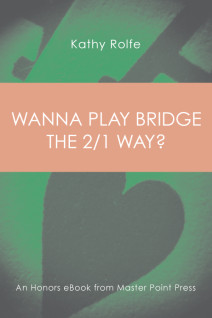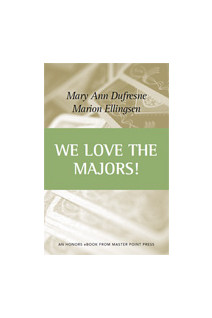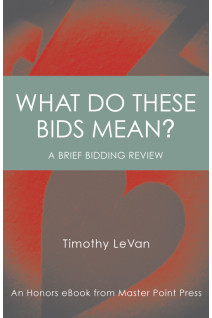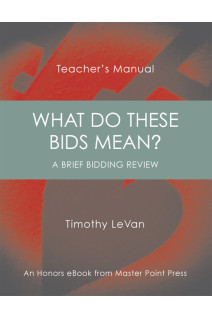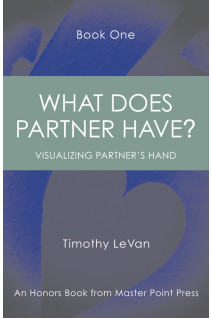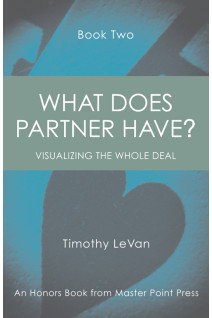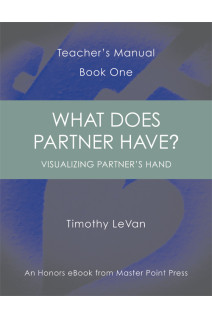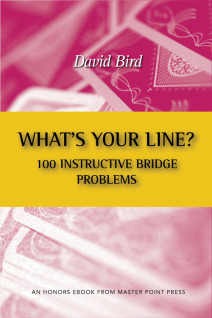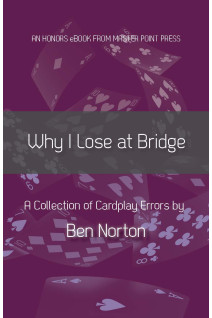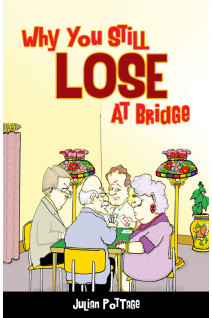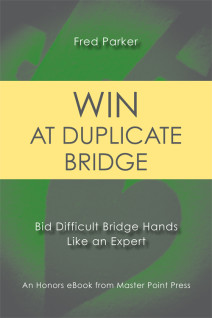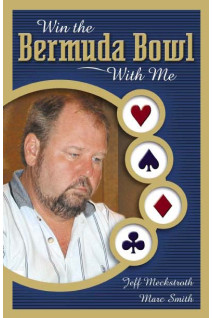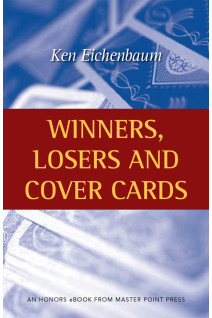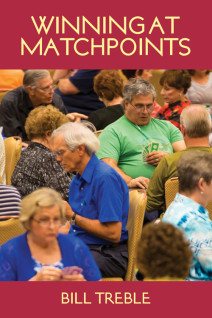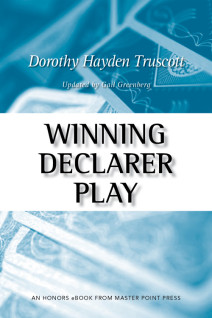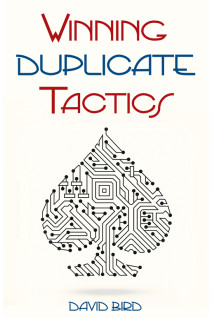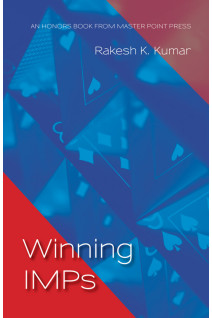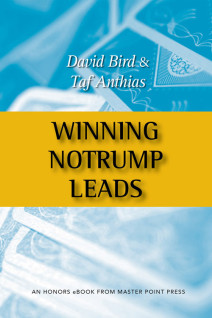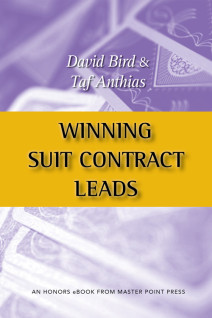All titles available from Master Point Press
Below is a complete list of all titles from Master Point Press
Wanna Play Bridge the 2/1 Way?
Start Early! 2/1: More power, more fun This book can be used as an absolute beginner book, teaching the 2/1 bridge bidding system from the start. Use just Chapters 1-5 to teach children as young as 6! They can learn how to play before they are ready to learn how to bid. Older than 9, kids can move right along with adults into learning the bidding system. The book can also be used by a novice player who has the mechanics down but who still needs help with bidding structure and playing tips as well as scoring. Those players can start with Chapter 6. If you already play a good game of Standard American but want to switch to 2/1 then you should start at Chapter 11. If you already know 2/1 but don’t know a couple of other conventions needed when responding to an opening bid of a major suit, then perhaps you just need Chapters 14 and 15. There are dozens of deals for practicing both bidding and play. Use the book the way that suits you best!
We Love the Majors
Want to learn to play bridge? Let Mary Ann Dufresne and Marion Ellingsen get you started. You won't find a clearer, simpler presentation of the basic guidelines. Plus, the authors tell you all about their winning bridge strategy: bid a major whenever you can! Unlike many beginner books, We Love the Majors doesn't oversimplify the game for ease of consumption. This is an honest presentation of the modern game complexities and all but expressed in terms everyone can understand and apply. Want to teach beginning bridge? You couldn't ask for a better student text. Students and teachers will find hundreds of examples, homework to test student knowledge and practice deals to play. The book includes an introduction to Stayman, transfers, and modern guidelines for competitive bidding. When looking for the right bid, We Love the Majors! Bridge teachers may also be interested in purchasing the Teacher's Manual for We Love The Majors.
What Do These Bids Mean? A brief bidding review
Visualize everyone’s hands from their bids only. What do their bids promise? Deny? Multiple possible Bids and Rebids show minimum, medium, or maximum hands. Are they forcing? What cards and points are required? What Seat are you in? Your bids will vary based on your Seat. Review a Bidding Concept and Bidding Sequences. Consult What Do These Bids Mean? and Thoughts. Take the Quizzes and check your Answers. Four players bid Final Test Hands. See the Full Deal and Suggested Bidding. Not Sure? Refer to Examples and Text Pages.
What Do These Bids Mean? Teacher's Manual
Teacher’s Manual to accompany What Do These Bids Mean? Step-by-step exercises visualize everyone’s hands from their bids only. No cards! Multiple possible Bids and Rebids show minimum, medium, or maximum hands. Only the book’s 15 Quizzes & Answers show actual hands. 36 Final Test Deals give all four hands to bid and compare with Suggested Bidding. Chapters may be taught individually or as sets of classes. All activities are taught at bridge tables with just Bidding Boxes. This Teacher’s Manual contains 10 additional Quizzes & Answers to hand out. They show just one hand, and how the surrounding bidding changes how that hand is bid.
What Does Partner Have? Book One
A Bidding Review for You and Partner In Book One, the opponents pass. You see only your South hand. Analyze partner’s bids. What do they promise? Deny? Are they forcing? What cards and points are required? Review a Bidding Concept. Bid Example Deals. Consult What Does Partner Have? and Thoughts. Take the Quizzes and check your Answers. Were you right? Not Sure? Refer to the suggested deals.
What Does Partner Have? Book Two
A Bidding Review for All Four Players A continuation of Book One. You see only your South hand. Visualize everyone’s hands. What do their bids promise? Deny? Are they forcing? What cards and points are required? Review a Bidding Concept. Bid Example Deals. Consult What Does Partner Have? and Thoughts. Take the Quizzes and check your Answers. Were you right? Not Sure? Refer to the suggested deals.
What Does Partner Have? Teacher's Manual Book One
Step-by-step exercises Teacher’s manual to accompany What Does Partner Have? Book One Visualize partner’s hand from his bids only. What do his bids promise? How many cards? How many points? Are they forcing? Chapters may be taught individually or as sets of classes. All activities are taught at bridge tables with cards and bidding boxes. Each chapter has additional Quizzes and Answers to hand out.
What Does Partner Have? Teacher's Manual Book Two
Step-by-step exercises Teacher’s manual to accompany What Does Partner Have? Book Two A continuation of Book One – now with all four players bidding. Step-by-step exercises visualize everyone’s hands from their bids only. What do their bids promise? How many cards? How many points? Are they forcing? Review new bids available now that opponents are bidding, too. Chapters may be taught individually or as sets of classes. All activities are taught at bridge tables with cards and bidding boxes. Each chapter has additional Quizzes and Answers to hand out.
What's Your Line? 100 Instructive Bridge Problems
Fine Tune Your Cardplay This collection of 100 problems features instructive deals that have appeared in David Bird’s bridge columns over the past few years. The author has aimed to present problems that will give you a good chance of finding the solution. They illustrate a wide range of card-play techniques. Each problem is presented in two-hand format on a righthand page, with the solution and full deal overleaf. In addition, you will find a large number of ‘Bidding Tips’ and ‘Points to Remember’. If you fail to solve a problem the first time, this is no cause for concern. By reading the solution and clearly written explanation, you will have a greater chance of handling a similar situation the next time you meet it at the table.
Why I Lose at Bridge - A collection of cardplay errors
LEARN FROM BEN’S MISTAKES Here is a rare jewel: an expert bridge player admitting to his own mistakes. In this, his first book, England international Ben Norton passionately describes the cardplay errors he committed in various events over a span of some three-and-a-half years. From a game at the local pub to the top echelon of world class competition, each of these errors is instructive no matter the setting. Whether you want to learn something, see some interesting deals, or simply laugh at how badly the author played, this book will oblige while affording you a unique opportunity: some write better than they play, and you can officially be the judge.
Why You Still Lose at Bridge
S.J. Simon’s classic Why You Lose at Bridge, dispensing advice to the improving player through archetypical bridge characters such as Futile Willie, the Unlucky Expert, and Mrs. Guggenheim, is regarded as one of the best books ever written on the game. In this follow-up book, Julian Pottage uses the same approach to discuss common failings of modern club players – misdescribing your shape, overvaluing your hand, bidding the wrong slam, playing a flawed system, giving the wrong signal, making losing leads, and many more.
Win at Duplicate Bridge
Win at Duplicate Bridge, previously published by Vivisphere Publishing, teaches modern bridge bidding techniques to the intermediate duplicate bridge player. It describes and fully explains all modern conventions, including the two over one system. The book is full of examples on how to bid difficult hands, and explains the nuances of expert bidding practices. It advises the player, which conventions are most useful and how to play them. It is an invaluable teaching and reference book for any serious bridge player. What you will learn from this book: What conventions you need for a winning edge. How to bid conventions like Lebensohl, New Minor Forcing, Inverted Minors, Jacoby 2NT, etc. When to overcall with 8 points, but pass with 16. How to respond with borderline hands. When to raise partner’s suit rather than bid your own suit. When to open 1NT with a 5 card major. When to preempt, and at what level. How to respond to a take-out double, a negative double, or a responsive double. The type of hand you need to have to balance. How to bid difficult hands in competitive situations. How Two over One differs from Standard bidding systems. When to use 4 Clubs as a Gerber bid. When to ask for Aces or Key Cards, and when to cue bid. Modern and best practices for leads and signals. Each Chapter has Quizzes with fully descriptive answers, in order to enhance the learning experience.
Win The Bermuda Bowl With Me
An over-the-shoulder look at the thought processes of one of the world's best players as Jeff Meckstroth takes the reader through the highs and lows of winning the Bermuda Bowl - the world teams championship. Written in the style of Terence Reese's classic Play Bridge with Reese, this book gives readers a chance to make their own decisions at critical stages in each deal, and compare their solutions with the authors. The narrative does not follow any specific world championship event, but all the deals are ones that Meckstroth actually played in Bermuda Bowl competition.
Winners, Losers and Cover Cards
You began by learning to count points, but that only got you so far. Then, someone introduced you to a new idea, Losing Trick Count. Better in theory, sure. But how do you use it? A response shows at least 6 high-card points, but how many losers? How many of these mysterious 'cover cards'? What's the range? Plus, something just seems wrong with the whole thing! How can A 3 2 be just as good as Q 3 2? That cannot be right! Counting Goren high-card points is much easier, and is a very reasonable gauge for bidding square hands. When things start to get distributional, however, you know that you need a better way to evaluate your hand. The concept of winners, losers, and cover cards really seems to be the right path, allowing you to escape from counting points into the world of counting TRICKS! In Winners, Losers and Cover Cards, Ken Eichenbaum reveals not only the secrets an expert would use to better evaluate the real power (or weakness) of your hand, but also how to use this knowledge to your advantage in a myriad number of ways. The author explains a fresh take on popular conventions and treatments, within the context of real auctions facing you at the table, and introduces novel methods, allowing you to maximize the benefit of your new understanding.
Winning at Matchpoints
Most players would agree that matchpoints is harder than IMPs – it’s certainly different. Yet many players approach the two forms of scoring in the same way. In this book, the author explains the differences in approach, the whys and wherefores of the right way to bid, play and defend at matchpoint scoring for optimum results.
Winning at the Club
Bridge in 2020 went online at the club. With daily opportunities to observe players while running games, teacher Matthew Thomson started on a quest to understand why players were so often making bids and plays that surprised him. This led him to ask the question, "How can I best help the club player?" Selecting a daily hand for lessons shared before each online game saw immediate results, allowing Thomson to refine his advice to best assist his players. This book collects these daily lessons together, and it will help club players develop into winners. Thomson's guidance takes a pragmatic approach to what works best at the club. Winning club bridge is different from expert bridge. It's achievable by all club players willing to think and to challenge themselves. In sections of real-life discussions that he titles "Club Chat", the author captures myths and misadvice so often present at the club, which all players can relate to and learn from.
Winning Declarer Play
LEARN DECLARER PLAY FROM AN EXPERT This classic book, a bestseller for more than forty years, has been updated for this edition by Gail Greenberg, a frequent partner of Dorothy Truscott, and like her a World Champion. Dorothy had a unique ability to make complex bridge concepts simple to understand, and everything here, from the basics to the most complicated squeeze or endplay, is described in an interesting and easy-to-follow way. In addition to the technical material, the reader will also learn when and how to use deceptive tactics to give the opponents a chance to make mistakes. Each chapter has many sample hands to test and challenge the reader.
Winning Duplicate Tactics
Duplicate bridge is a different game. It’s true that you can get by if you play exactly the same way as you would in a home social game or a team match. Duplicate pairs is a highly competitive game, though, and few contestants are happy just to ‘get by’. They want to win — not just once in a while but regularly! To be successful at duplicate pairs, you must adjust your bidding. You must know when to compete vigorously, taking a risk in doing so. You must also know when it is right to bid conservatively. You have to understand which contract to choose in various situations. In the play and defense you meet similar dilemmas. Should you risk the contract for a lucrative overtrick? Should you risk giving away an extra trick in defense, hoping that you can beat the contract? This is a book that every novice bridge player needs to read before that first pairs game at their local club.
Winning IMPs
This book highlights the strategies that contribute to success in team games. Of course, there is no magic formula for winning at bridge, given the inherent complexity, the incomplete information available to both sides, and the psychological elements involved. However, there are some characteristics common to consistent success: good bidding methods are essential these methods are useless without courage as declarer, care and planning are vital as a defender, a little thought goes a long way Winning IMPs in Teams and Swiss Pairs events requires good methods, skill, courage and a bit of luck. Winning often depends on getting to thin games (we bid it, you try to beat it!) and reasonable slams. Bidding is therefore a primary focus of this book. The rest of the time, significant IMP swings largely relate to (not enough) care and thought in the cardplay and defense. The remainder of the book centres around these areas of focus. Reviews Surprisingly, there has been little in bridge literature that focusses on the strategies of IMP bridge. Rakesh Kumar’s new book fills this void nicely. For 20 years he’s had a column in the NSWBA Bulletin covering his success and failures at the table. Rakesh’s first bridge book, Winning IMPs, is based on material from his column and discusses the strategies that lead to successful IMP play. This text focuses on the four essential areas of winning IMPs bridge.And all the key points are illustrated with many hands taken from actual tournament play. - Australian Bridge Federation
Winning Notrump Leads
To discover which opening lead is best from a given West hand against a particular auction, the authors use computer software to generate 5000 deals that match the North-South bidding. (The West hand remains the same and the other three hands are chosen randomly.) The software then plays these deals automatically, seeing which of the 13 possible opening leads works best at both IMPs (rubber bridge/Chicago) and match-point pairs. By analysing the results, the authors pass on to the reader the secrets of finding the best lead against notrump contracts on a wide range of different auctions. Suppose the bidding goes 1NT - 3NT and you have to find an opening lead from ♠ J 8 6 ♥9 5 ♦K Q 7 2 ♣K J 7 2 You may be surprised to hear that the ♠6 is the best lead at both forms of the game and the ♥9 is the second-best lead!
Winning Suit Contract Leads
COMPUTER ANALYSIS OF OPENING LEADS Winning Notrump Leads was a ground-breaking and very well-received book that used the power of computers to determine which opening leads work best against a variety of auctions at notrump. Using enhanced software, the authors now turn their attention to suit contracts. They generate millions of random deals, retaining those that match the chosen auction, for example 1S-2S-4S. By playing these deals automatically against each of the 13 possible opening leads from a given hand, they are able to discover which lead is most likely to beat the contract (also the best lead at matchpoint pairs). The authors provide insightful commentary to each result, answering timeless questions such as: * When should I lead a trump? * When is a doubleton a good opening lead? * Should I lead differently against a partscore? * Should I make an aggressive or a passive lead? * Should I lead an ace against a small slam? * Which leads work best against a grand slam? By using the number-crunching computer power available nowadays, there is no longer any need to rely on general opening-lead guidelines passed down by our ancestors. We think you will be surprised by many of the discoveries made during this investigation!
World Bridge Championships 2023
Published by the World Bridge Federation, the official book of the World Bridge Championships 2023, held in Marrakech, Morocco. It is comprised of approximately 340 full colour pages. The principal contributors are Mark Horton, David Bird, Maurizio Di Sacco, Barry Rigal, Brian Senior & Marc Smith. The book includes many photographs from the championships, a full list of results and extensive coverage of the major championship events.
World Class - 21st Century
Marc Smith’s original World Class, published in 1999, became a classic. This all-new edition features the world’s best players of today discussing their lives, at the table and away from it — how they started, their best and worst bridge memories, their favorite hands, why partnerships work well, and their hopes for the future.You may recognize the names from your bridge magazine or from watching them play online. This book will show you their human sides. You will relive their triumphs and disasters at the bridge table, and pick up plenty of tips to improve your game. Get to know many of the world’s best players, male and female, young and old.
World Class 21st Century: USA and the Rest of the World
Marc Smith’s original World Class, published in 1999, became a classic. This all-new edition features the world’s best players of today discussing their lives, at the table and away from it — how they started, their best and worst bridge memories, their favorite hands, why partnerships work well, and their hopes for the future.You may recognize the names from your bridge magazine or from watching them play online. This book will show you their human sides. You will relive their triumphs and disasters at the bridge table, and pick up plenty of tips to improve your game. Get to know many of the world’s best players, male and female, young and old.Players in this volume:Marcelo BRANCO (Brazil)Chip MARTEL (U.S.A.)Kerri SANBORN (U.S.A.)Bobby LEVIN (U.S.A.)Michel ROSENBERG (U.S.A.)Joey SILVER (Canada)Miguel VILLAS-BOAS (Brazil)Irina LEVITINA (U.S.A.)Jill MEYERS (U.S.A.)Wenfei WANG (China)Renee COOPER (Australia)Jacob FREEMAN (Canada)Adam KAPLAN (U.S.A.)Marty BERGEN (U.S.A.)Eric KOKISH (Canada)
